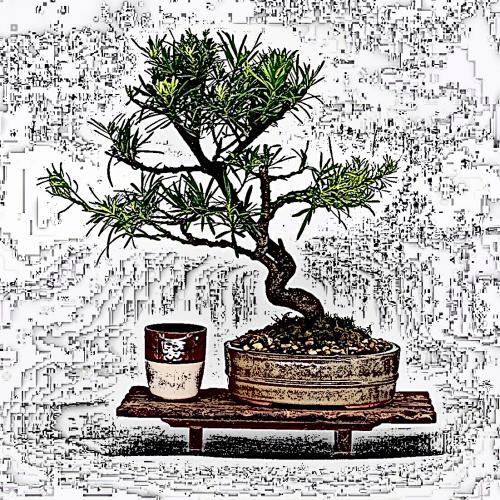Bonsai class 3

[This is a continuing series of spontaneous and unrehearsed "classes" on the subject of bonsai. Many new readers were coming on board asking about how to get started. I believe you should just start making bonsai. So, I will try to lead you through creating your first. Besides this gentle counsel, be sure to read the FAQ (which appears periodically) and search out some good books or people to introduce you to the subject. I will post sporadically with a subject containing the word "Class". I am going slow, so be prepared to be frustrated. If you have questions or comments about building your own first bonsai, post them "Re:" this thread (and if you have other questions, try to avoid a subject containing "Class").]
I went to the hardware store to buy some plumbing and, as usual, I took a swing through the nursery. A bunch of 1-gallon plants, normally US $5 to $7, were on sale for $3. Hmm. I decided it might be a good thing if I played along at home with you rookies. I wound up buying three--a mugo pine (p. mugo), a Japanese black pine (p. thunbergiana), and a juniper (j. procumbens nana). Because just the day before, at the drugstore, I had seen a small, scrawny juniper as a ready-made bonsai on sale for $12, I am smiling, knowing that soon I will have 3 nice bonsai, that in total cost less.
The first thing I did was cut away the part of the plastic pots above the soil level so I could see, and get at, the whole plant. Repotting into a slightly smaller container would work, too, so that "ground" level was accessible.
I couldn't resist; to help myself see what I had, I plucked the needles that were growing on the lower part of the trunk. It is spring, here in California, and each of the plants is growing vigorously. Each has a very dense growth of branches. I am very tempted to thin out some of the densely growing branches, if only to better see the structure of the trees, but I guess I will follow my own advice and study these trees a bit before doing any pruning. (And, it's hard not to pinch back those rapidly growing candles, but I'll wait.)
===
So what tactics do we have to give our bonsai the form of a mature tree? Fundamentally, there are two: removing (or adding) material and shaping existing material.
Raw stock will usually require that some, or a good many, of its branches be removed by judicious pruning. (If you are a positivist like me, you can just think of pruning as adding to the "negative space".) Adding material--grafting branches onto a tree--is not something you need to get into right away, but keep in mind that it is possible in those situations that demand it. Another way to add material takes a little more time and cooperation from your subject: letting the tree grow it. Sometimes a branch can be coaxed to grow right where it is needed. Actually, because the bonsai is a living tree, it is always adding more branches for you to work with. So, your job of shaping the bonsai is never done! You have been warned. Pruning is your main ally, and with just a half-hour of clipping on some raw material you can make something prettier than a cheap ready-made bonsai, something quite beautiful, especially to the non-initiated. I know; I've seen the jaws drop.
Existing branches are usually shaped with a mechanical restraint, usually copper wire. (Other methods include tying branches to rigid stakes, or hanging weights from branches.) Copper wire is wrapped around a branch and then the branch is bent into the desired shape. This kind of stress causes slight (hopefully invisible and painless) damage to the branch, and, much later, when the damage has healed and the wire removed, then the branch will retain the shape it was given. For instance, wiring youthful upward-growing branches and bending them down below the horizontal, is how we achieve that appearance of the limbs of an older tree being affected by years of gravity and weather. Long, bare limbs can be given beautiful, sinuous forms that bring the foliage in closer to the trunk. Annoying kinks can be straightened out. It is a powerful tool.
===
Last time, I left you with a question about how tall will your tree be. Note that I used the future tense, for its height is mostly up to you. You could make the tree taller than it is by stretching out the existing apex, but more likely you will make the tree a little shorter, for that is one way to achieve the wider trunk to height ratio that is characteristic of a more mature tree. Now that you have identified the apex of your little tree, it may be time to reconsider. The existing apex may have to go!
Now, you could just lop of the upper part of the trunk, but that will look like a tree with its top lopped off. But what if you remove the top just above a small branch that currently grows horizontally, and you use wire to bend that branch into a more vertical position? Instantly, you have a new apex, I hope a lower one, and perhaps a "new, improved" trunk that grows narrow a little more quickly. And, if that branch was one that had been growing toward the front of the bonsai, the scar left by removing the apex is now hidden on the back side of the tree. Luck? No. Planning!
[Are words clear enough here? I have a feeling that I'll eventually have to do some ASCII artwork to communicate some of these ideas. Holler if a crude picture would help!]
I have hinted at it, but let me state it directly: the height of the tree depends on which side is the front; the front of the tree depends on the first branch; the first branch depends on the height of the tree. Do you get the feeling you are solving a puzzle? This is why thinking about the design is so important. You will find yourself often compromising between what you want and what your bonsai wants.
===
I am still not advocating you attack your subject yet. Keep thinking. I just want you to know some options you have while you are planning your design.
Think about which branches are undesirable and in need of pruning. Think about which of the remaining branches will need to be reshaped. Think about how tall your bonsai will be. The final apex of your bonsai could be anywhere on your tree right now. So, deciding how tall your tree will be may not be as simple as it sounded.
[Warning: pruning is better done at some times of the year than others. And, it varies by location and by tree. Here is where a bonsai book comes in handy. They often include such data. When we finally get to it, if it's not a good time to be cutting away at your tree, you may want to be very conservative and just prune a few branches for practice, saving the extreme work for the right time of year.]
===
Next time I want to talk about aesthetics--of branch structures to avoid or eliminate, and what kinds to keep. ASCII art, I can see it coming.


















